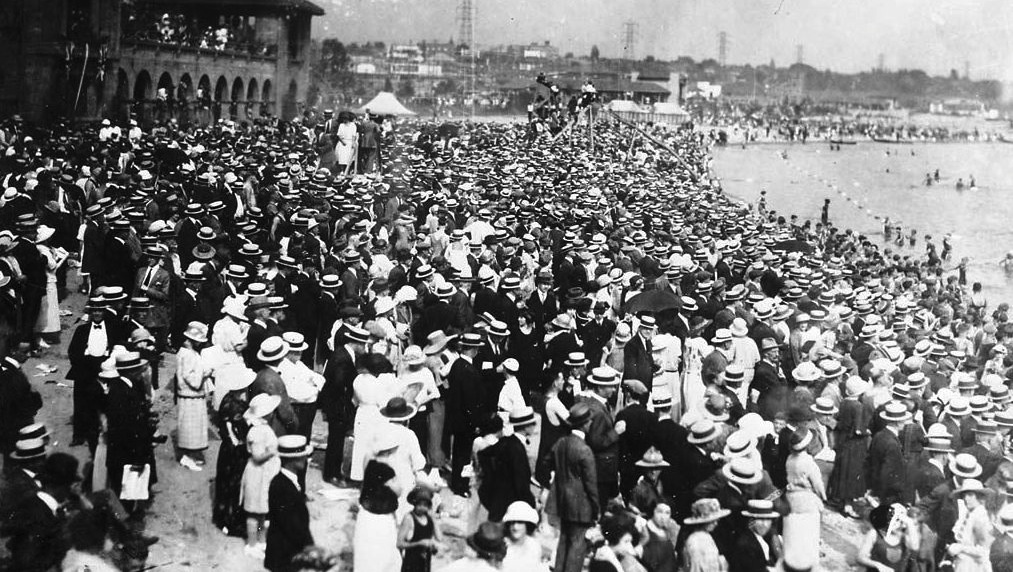 |
| Dressed appropriately for the beach in Toronto 100 years ago. |
All this talk about the 100-year anniversary of the sinking of the Titanic has made me think about the history of naturism. You can see in the various photos of the time just how restrictive and uncomfortable clothing was. Not even the period’s bathing suit offered a respite. In their 1931 book, Among the Nudists, Frances and Mason Merril observed:
“…there never was such a thing as a comfortable bathing suit. Wool scratches, cotton grows heavy and sags as soon as wet, and silk becomes slimy and nasty to the touch; either a suit is so tight that it cuts, or else it is so loose that is flaps and bags as soon as you enter the water.”
When you remember that those bathing suits usually covered you from ankle to neck, that description becomes even more vivid. So the initial motivation for naturism/nudism was comfort and health. John Langdon-Davies, (1897–1971) the British author and journalist, wrote The Future of Nakedness in 1929. In it he makes the argument that the future of humankind is to be naked:
“Science, always the destroyer of good breeding, has discovered or rediscovered the uncomfortable fact that nakedness is a medicine for the sick and an inspiration for the healthy; that clothes, far from being the ramparts of a beleaguered city, are the investing army striving to encompass its fall; that a coat, a pair of trousers, and a waistcoat are barriers between the starving, hard-pressed tissues within and the relieving army come to raise the siege.”
Of course, that was certainly an outrageous thought in Europe at a time where a man never displayed his bare chest and a woman would not dare to even show her ankles in public. Yet by the time the Titanic sank, Heinrich Pudor (under the pseudonym of Heinrich Scham) had written Nackende Menschen (Naked People) in the 1890s and Richard Ungewitter had published Die Nacktheit (Nakedness) in 1906. (which reportedly sold over 90,000 copies)
When the Titanic hit that fateful iceberg at 11:40pm, Paul Zimmerman’s Freilichtpark Klingberg, north of Hamburg, Germany, had already been in existence for nearly a decade. It was founded on a philosophy of nude healthy living: fresh air, sunlight, frequent physical exercise, vegetarian diet, no smoking and no alcohol. Jan Gay described her visit with Zimmerman at Freilichtpark in her 1932 book, On Going Naked. She complained of the regimented exercise schedule and the “unsatisfactory” vegetarian meals. The Merrils were far more appreciative in their description:
“We had come to Klingberg for a few days–to see it. We had stayed a month, leaving at the last possible minute and curtailing our stop in Hamburg to one day. We had sacrificed not only such an inveterate habit as meat eating, but several weeks of our long-planned tour, for a physical rest and benefit, a mental peace and joy that we had never found before. For a month we had played like children.”
At that time already, you can see the developing difference between mere nudists and those with a naturist philosophy. At the end of their book, the Merrils observe:
“The naturists, advocating a life in accordance with natural laws, consider the practice of nudity a useful hygienic measure, though not the most important.”
But regardless of whether it was naturism or nudism at that time, the foundation of the movement was physical. The psychological benefits (acceptance of self and others) came later. Perhaps people didn’t have as much body shame back then. Or it could be that they didn’t recognize until later the emotional damage that this shame creates. It is certainly clear from the photos and writing of the day, that pre-WWII naturists and nudists sought physical perfection. (as did mainstream western society) But while today we recognize the damage that body shame causes, it doesn’t seem to be getting any better. Everyday we are bombarded with messages that make us feel ashamed and insecure about what we look like. Media sexualizes and objectifies our bodies. More than ever, we need naturism as an antidote to all those ills that afflict our world.
Image from the City of Toronto Archives via Wikimedia Commons










